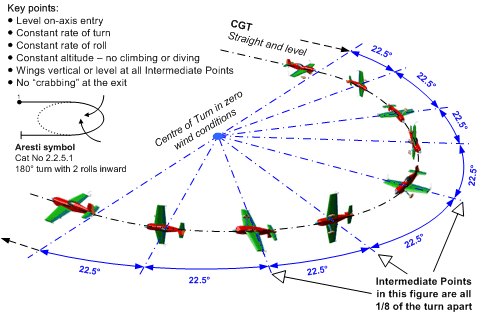The rolling turn or rolling circle is the king of aerobatics. I remember how I worked so hard to perfect it and thought I was flying it quite well, I was always a bit miffed that the judges didn’t agree but several years later I realised how much better I was able to fly it! The rolling circle is one of those figures that constantly improves with practice and is very rewarding to fly well. It is also quite remarkable how poor some of the “experts” are at flying it, they seem to rush it so as not to give the judges time to see the faults.
The criteria of “constant rate of turn” and “constant rate of roll” while flying level are really important and have implications. Of course the sneaky “no yaw at the end” is something to strive towards. The constant rate of turn requirement is not possible to achieve without using lots of rudder. The “no yaw at the end” means that you have to be really aggressive with the rudder so that you. have the facility to minimise any yaw at the end so that the judges cannot see it.
It is really important to fully understand the judging criteria for this figure as you need to constantly critique yourself as you strive for perfection.

It is important to have a good line feature and measure your turning progress against it. Set power for 95 knots, Zero your g meter and noting your exact height. As you start, move the throttle forward about an inch as the figure is very draggy and you need to be able to sustain 95 knots. Of course with experience you will be able to refine the additional power needed. Start at 90 degrees to the line feature, at 95 knots. If you go much faster the aircraft will skid rather than turn with rudder. If you fly much slower then the aircraft will flick out. Remember that the judging criteria require that your rate of turn is constant, therefore you must turn as much when you have no bank, as you do with 90 degrees of bank, therefore if turning left, push hard with the left rudder and slowly begin to roll to the left. Look forward and keep the nose the horizon. The rudder will be trying to bring the nose down and the elevator will try and bring the nose up. The controls should be balanced so the nose stays in the correct place. You are aiming to be 22.5 (1/8th) of the way round by the time the wings are vertical. As the wings approach vertical the left rudder should be reduced to no rudder and as vertical is passed right rudder should be introduced, again rudder works against elevator to keep the nose in the correct position which is about 20 degrees above the horizon. By the time the wings are level inverted you should have turned 45 degrees (key point) and have lots of right rudder applied and no back pressure on the stick, as it passes level you should be pushing on the stick, really quite hard. Again rudder and elevator oppose each other to keep the nose in the correct position above the horizon as the wings come to the vertical, the aircraft should have turned 67.5 degrees and right rudder should be replaced by left rudder. It is important to get lots of left rudder in because you need to hit the 90 degree point with no yaw. This means in effect aiming for 100 degrees before the yaw is released.
Bring this figure all the controls should be applied smoothly. Aim to push much harder than pull. The g meter should read +2 and -2. You should be at the same height as when you started and pointing 90 degree off the original heading. Remember that in a left turn as you feed in left rudder you will need to reduce aileron and as you feed in right rudder you will need to increase aileron to ensure the rate of roll remains constant. Power should be adjusted so that while not gaining or losing height, the speed remains roughly constant.
This needs to be practiced until you can fly it smoothly, hitting all the cardinal points with a constant rate of roll and a constant rate of turn without losing or gaining height. Remember that you will need to do this in both directions! Then try doing 4 rolls in 360 degrees of turn always being sure to check your cardinal points. Then progress to doing 3 rolls in 360 degrees of turn.
Of course it is best to learn this figure with an experienced instructor. Feel free to contact Adrian.Willis@BritishAerobaticAcademy.com or 0771 2864413 to book a lesson in our Extra 200.
This contains some content with kind permission from the BAeA https://www.aerobatics.org.uk